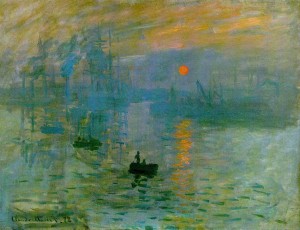This is the painting that gave rise to the Impressionist movement in the late 19th century. This painting by Claude Monet is dated 1872. Its subject is the harbour of Le Havre in France, using very loose brush strokes that suggest rather than delineate it. Monet explained the title later: “I had sent a thing done in Le Havre, from my window, sun in the mist and a few masts of boats sticking up in the foreground… They asked me for a title for the catalogue, it couldn’t really be taken for a view of Le Havre, and I said: ‘Put Impression.’”
Radicals in their time, early Impressionists broke the rules of academic painting. They began by giving colours, freely brushed, primacy over line, drawing inspiration from the work of painters such as Eugène Delacroix. They also took the act of painting out of the studio and into the modern world. Previously, still lifes and portraits as well as landscapes had usually been painted indoors. The Impressionists found that they could capture the momentary and transient effects of sunlight by painting en plein air (in plain air). Painting realistic scenes of modern life, they portrayed overall visual effects instead of details. They used short “broken” brush strokes of mixed and pure unmixed colour, not smoothly blended or shaded, as was customary, in order to achieve the effect of intense colour vibration.
Journal Topic:
What is your “impression” of this painting? Does it still seem to break the rules? Do you think that this painting “capture[s] the momentary and transient effects of sunlight?” What do you like or dislike about it?
Sources:
http://en.wikipedia.org/wiki/Impressionism
http://en.wikipedia.org/wiki/Impression,_soleil_levant





 Please support this site by contributing to the coffee fund. All donations are appreciated.
Please support this site by contributing to the coffee fund. All donations are appreciated.